I was born in Malacca – now officially called Melaka – a small Malaysian state on the Straits of Malacca. Even though my passport says Melaka, like most people who know the region I still think of it as Malacca. It may be one of the smallest states in Malaysia, however, there are plenty of things to do in Malacca.
This state is a fascinating melange of culture and history. It’s only a couple of hour’s drive from Malaysia’s sleek high rise capital, Kuala Lumpur, yet it’s a world away when you compare Malacca’s old-world ambience to that of Malaysia’s capital. Malacca has a similar vibe to that of Penang.
Contents
- Melaka
- 20 Things to do in Malacca
- 1- Cruise the Straits of Malacca
- 2- Explore World Heritage history
- 3- Visit the Melaka Cultural Museum
- 4- Learn the secrets of Bukit China
- 5- Explore nautical history at the Zheng He Museum
- 6- See A Famosa
- 7- Climb the hill to the Ruins of St Paul’s
- 8- Discover Dutch Square
- 9- Hunt for antiques and spices
- 10- Visit the Street of Harmony
- 11- Explore the Baba & Nyonya Museum
- 12- Taste the food in Malacca
- 13- Dine at the Portuguese Settlement
- 14- Watch a Portuguese folk dance
- 15- Discover Kampung Chitty
- 16- Enjoy the view at Menara Taming Sari
- 17- Visit the Maritime Museum
- 18- Have fun at A Famosa theme park
- 19- See the animals at Melaka Zoo
- 20- Spend the day at Melaka Wonderland
- Weather in Malacca
- Choosing a hotel in Melaka
- How to get to Malacca
- 20 Things to do in Malacca
Melaka
20 Things to do in Malacca
1- Cruise the Straits of Malacca
A body of water between Malaysia and Indonesia, the Straits of Malacca, has been the main trade route between India and China since the 17th century.
The 800km channel is the fastest way to get from the South China Sea to the Indian Ocean.
A three-day cruise between Singapore, Kuala Lumpur and Malacca is a relaxing way to travel the Straits of Malacca.
2- Explore World Heritage history
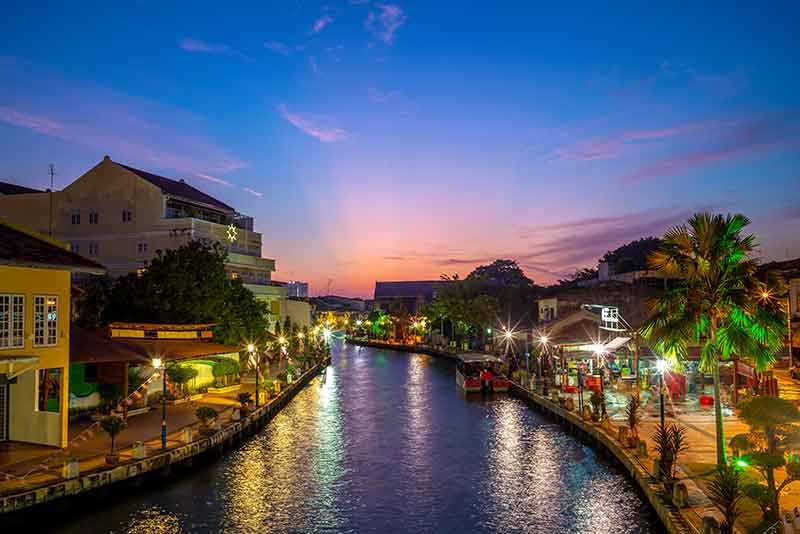
You could spend days wandering around Malacca’s historic centre where the buildings are a potpourri of Malay, Portuguese, Dutch, British and Chinese architecture.
Walking around the UNESCO World Heritage City is like strolling through a living museum where shops, restaurants, hotels and homes are housed in historic buildings.
Many of these buildings also house museums that exhibit the city’s wealth of history.
The port of Malacca was founded in the 14th century by Parameswara, a Sumatran prince.
It was once a thriving centre for traders from China, India, Arabia and Europe.
3- Visit the Melaka Cultural Museum
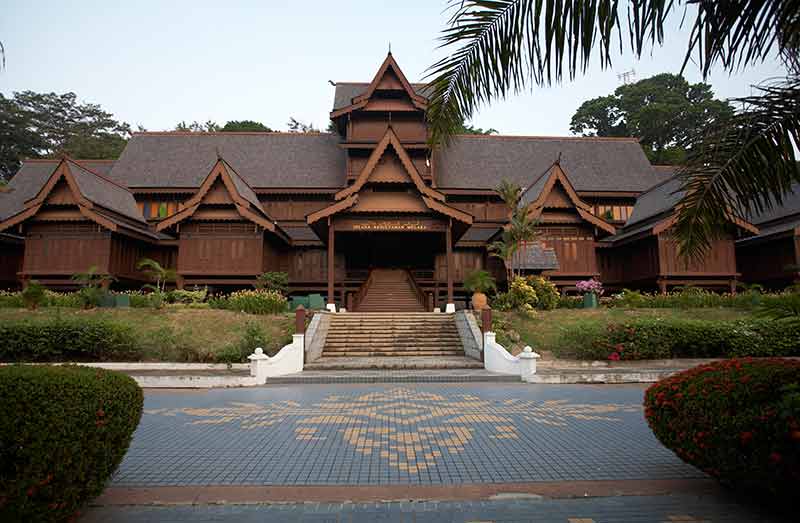
Malacca’s history reads like a children’s fairytale.
Legendary warriors such as Hang Jebat and Hang Tuah were part of Sultan Mansur Shah’s coterie.
The Sultan and his warriors lived during Malacca’s romantic age of magic and mystery.
The original palace occupied by the Sultan and his warriors burnt to the ground centuries ago but fortunately for history lovers, it has been reconstructed and now houses Melaka’s Cultural Museum.
The museum is a three-storey building with chambers and galleries that display Malay weapons, Malay traditional wedding costumes, jewellery, brassware and the royal bed-chamber.
Exhibits include prints and photographs.
4- Learn the secrets of Bukit China
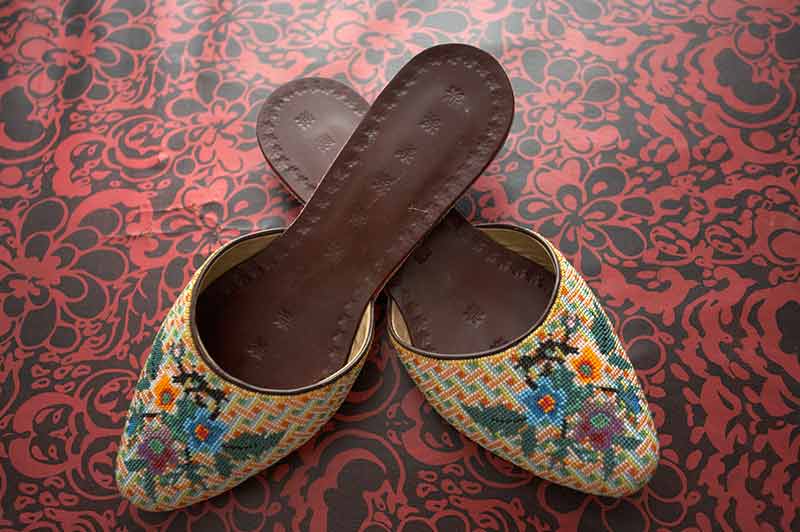
If you’re interested in how the Chinese influenced this part of the world, one of the things to do in Malacca is to visit Bukit China.
During the 1400s, Ming Dynasty princess Hang Li Po was sent to Melaka by the Emperor of China to marry Sultan Mansur Shah.
Hang Li Po brought 500 attendants and followers with her to live in Melaka.
Evidence of this migration can be found at Bukit China, China Hill, which is the largest Chinese graveyard outside China with 12,000 graves.
5- Explore nautical history at the Zheng He Museum
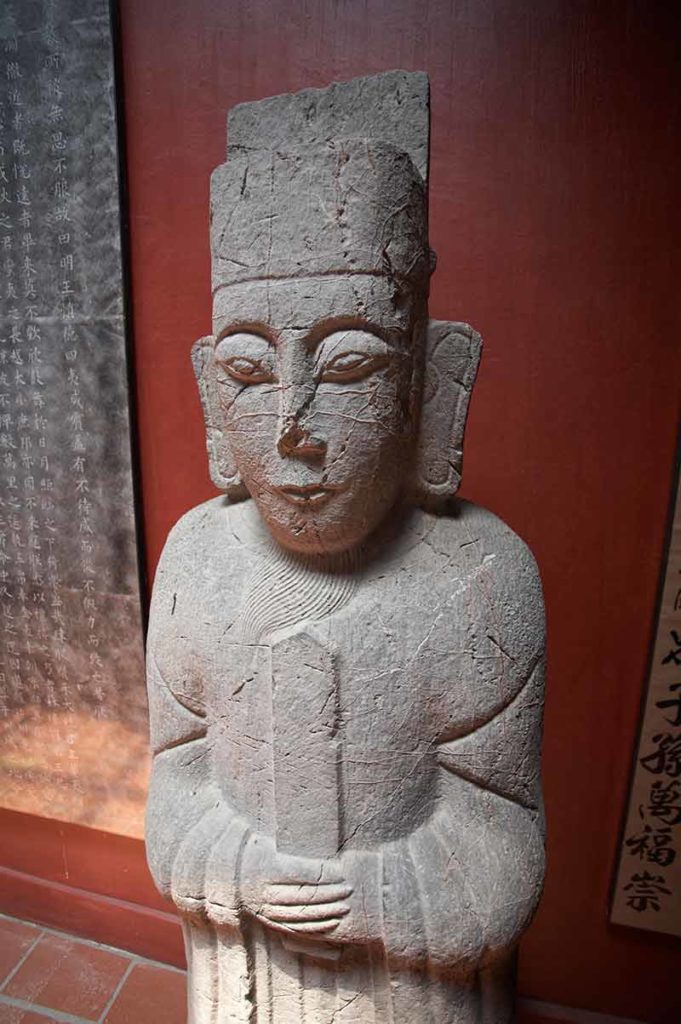
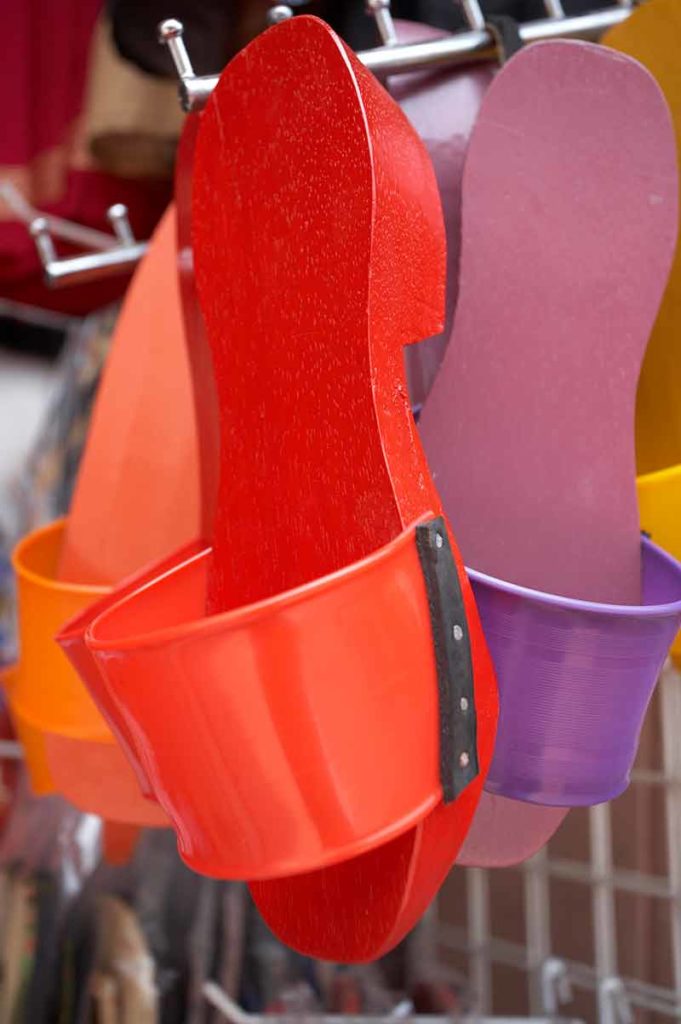
Another thing to do in Malacca for those interested in Chinese history is to visit the Zheng He Museum.
Admiral Zheng He (or Cheng Ho) is believed to have accompanied the princess on her journey.
In 2000 local historians in Melaka discovered a cluster of dilapidated buildings which they believed were built during the Ming Dynasty by Zheng He’s men.
The Chinese explorer, who is popularly referred to as the Christopher Columbus of Asia, is revered in Melaka.
One of the best ways to learn about Zheng He is to visit Melaka’s Cheng Ho Culture Museum, a four-storey building dedicated to the admiral.
The Cheng Ho Museum has exhibits from Yunnan, Nanjing, Beijing and Fujian.
Also on display here are porcelain pieces from the Ming period which were dug up by local historians at the site where the museum stands.
An impressive Ming Dynasty bell stands in a courtyard.
There is no other explorer in history that has attracted the controversy that surrounds the Chinese voyager.
In 2002, retired submarine commander and amateur historian Gavin Menzies in his book “1421: The Year China Discovered the World”, argued that a huge Chinese fleet circumnavigated and charted the world years before the first great European voyages of discovery.
The museum’s audiovisual room screens short films about Zheng He, there’s a wax room showing Chinese emperor Zhu Di meeting Melaka’s ruler Parameswara and an automated puppet show that runs through Zheng He’s life.
Ming emperors sponsored seven naval expeditions that had Zheng He sailing the waters of the Western Ocean to Southeast Asia, Indian Ocean, Middle East and Africa.
Zheng He’s ships were known as Treasure Ships.
It is believed the massive ships were big enough to carry 500 people.
The replica shows seven decks in the stern and four decks in the bow.
The bottom deck stored barrels of freshwater and rock used as ballast; above it on the second deck was the cargo. Here rows of jars of all sizes held food, water and wine.
A model of Zheng He’s mighty fleets shows the boats sailing across the ocean to discover new lands.
The evidence for this comes from shipwrecks, ancient maps and accounts from local people. But it’s a claim most western historians disagree with.
- 20 Famous Landmarks in Malaysia
- 30 Things To Do In Kuala Lumpur
- 35 Things To Do In Penang
- Living in Penang As An Expat
- 20 Things To Do In Melaka
- 15 Things To Do In Sabah
- 15 Things To Do In Cameron Highlands
- Malaysia Airlines Business Class Review
- 21 Beaches In Malaysia
- 20 Things to Do In Kuala Lumpur At Night
- 20 Malaysian Cities
6- See A Famosa
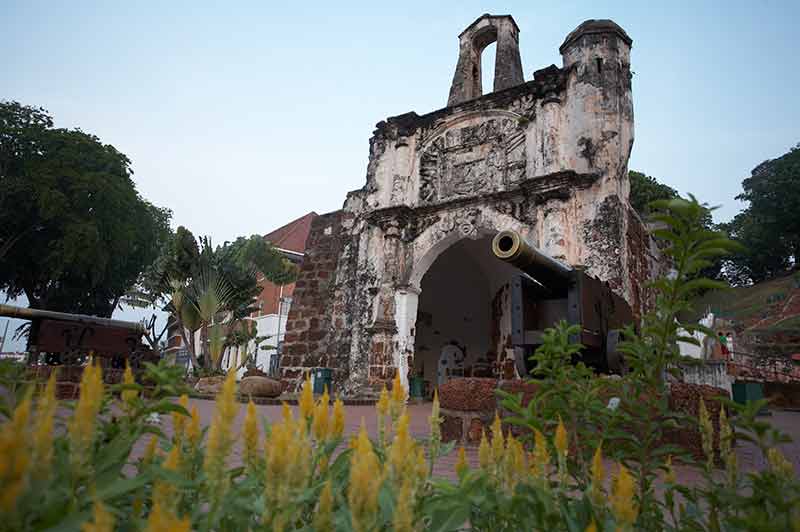
The Portuguese were the first Europeans to make their mark on Melaka.
So it’s not surprising that one of the top places to visit in Malacca is a Portuguese fort.
Alfonso de Albuquerque’s Portuguese fleet captured Melaka from Sultan Mahmud Shah in 1511.
The Portuguese ruled until the Dutch took control in 1641.
Then in 1795, the British booted the Dutch out and ruled until Malaysia gained independence in 1957.
The original wooden bridge that was the main target of the Portuguese attack still stands today.
Tourists swarm through the remains of A Formosa “the famous” Fort that protected the Portuguese for 130 years.
7- Climb the hill to the Ruins of St Paul’s
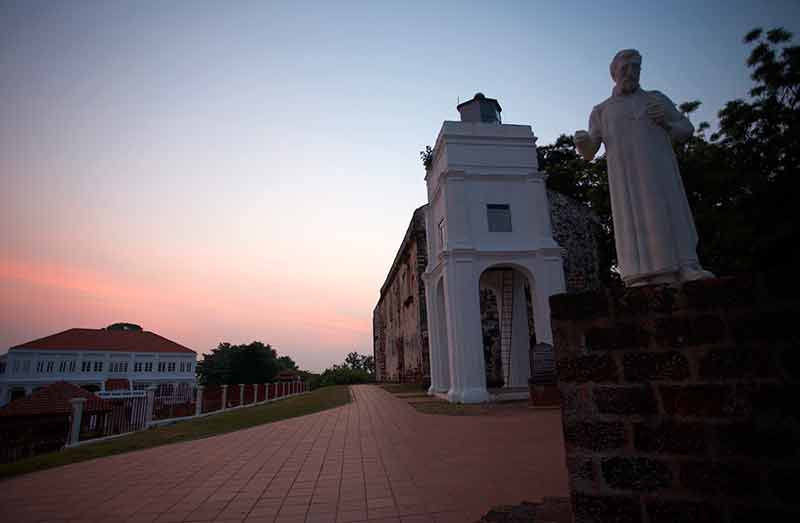
Near the fort, there are 140 steps that lead to the ruins of the Church of St Paul (if you find this intriguing you might also like to visit the Ruins of St Paul’s in Macao too) built in 1521 by a Portuguese sea captain.
At the Malacca ruins, you can buy rice-paper watercolour paintings of the river and the town.
But remember to haggle.
8- Discover Dutch Square
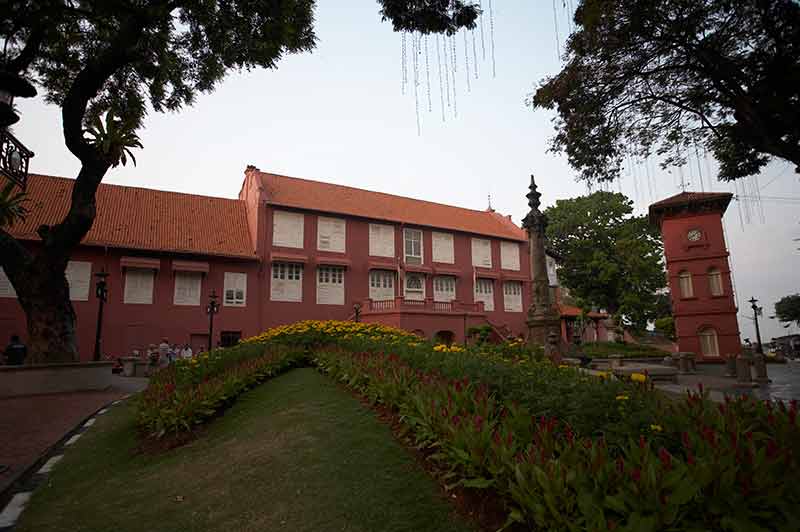
In Dutch Square, sightseers click away at the historic buildings.
Rows of trishaws line the shaded sidewalk.
Trishaw drivers rest with their feet on the handlebars, listening to traditional music while they wait for the next customer that will have them peddling furiously beneath the blazing sun.
The main building in Dutch Square is Stadhuys, a distinctive Dutch colonial architectural structure with solid doors, louvred windows and bricks imported from Holland.
Stadhuys is now home to the History and Ethnography Museum.
But it was once the town hall and the Dutch seat of power during the 17th century.
9- Hunt for antiques and spices
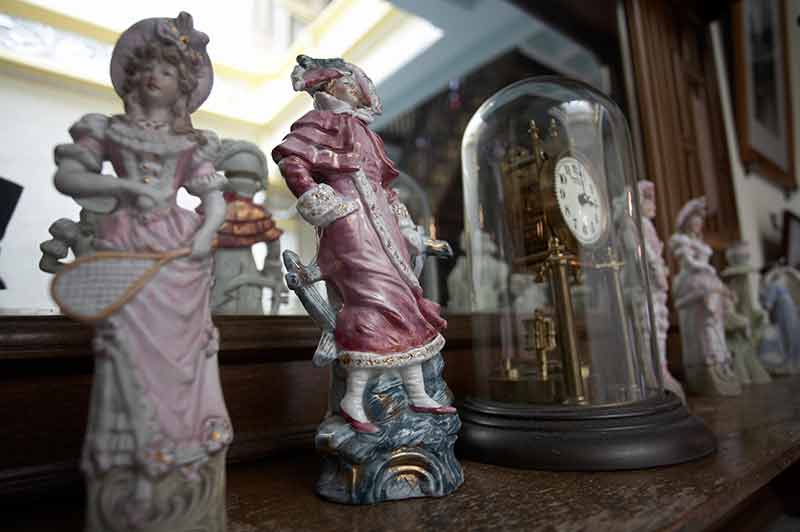
Throughout the city, narrow streets built for oxcarts and rickshaws are lined with mysterious-looking shops that beckon enticingly.
Jalan Hang Jebat or Jonker Street is an antique lover’s paradise for both genuine and reproduction antiques.
Narrow terrace shops are piled high with furniture, porcelain, silverware and brassware that once belonged to sailors, princes and wealthy traders.
The spice shops are packed with wicker baskets of nutmeg, cinnamon, cardamom and dry chillies.
Other shops are jam-packed with souvenirs, sandals and clothes.
Art galleries displaying modern art, traditional oil and Chinese paintings sit side-by-side with bars and local eateries.
There are also plenty of Western-style cafes in Malacca to hang out in.
10- Visit the Street of Harmony
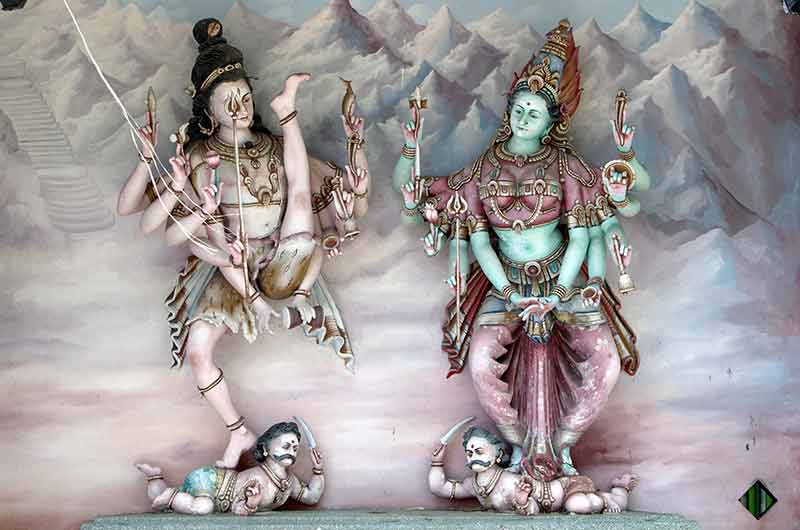
Amongst the warren of antique stores is the aptly named Street of Harmony.
This is perhaps the only place in the world where three houses of worship from three different faiths stand almost side by side.
It’s one of the few places in the world where you’ll see a mosque, a Buddhist temple and a Hindu temple in one street.
11- Explore the Baba & Nyonya Museum
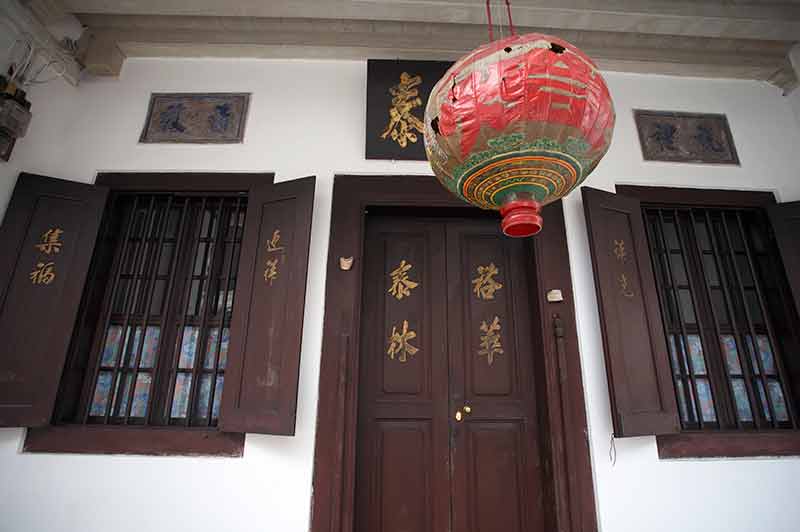
The legacy of Melaka’s multicultural past can be experienced by investigating the city’s unique cultural enclaves.
One such cultural gem, the Baba & Nyonya Museum, is tucked away amongst the antique shops.
The museum is a restored Chinese Baroque mansion with Neo-Classical European architecture.
It pays homage to the unique Baba and Nyonya culture mainly found in Malacca, Penang and Singapore.
The Baba and Nyonya’s (or Peranakan Chinese) were Chinese settlers who assimilated their culture with the Malay language, culture, spicy cuisine and dress style, yet retained most of their ethnic Chinese religious customs, including the practice of ancestor worship.
Among the museum’s highlights is a Chinese Blackwood dining set with inlaid mother-of-pearl, Dutch and Victorian antique pieces and a magnificent carved hardwood staircase decorated with gold leaf ornamentation.
When the British colonised Malaya, the Babas and Nyonyas earned the nickname “King’s Chinese” because they gave their children British educations and embraced British culture; many converted to Christianity.
12- Taste the food in Malacca
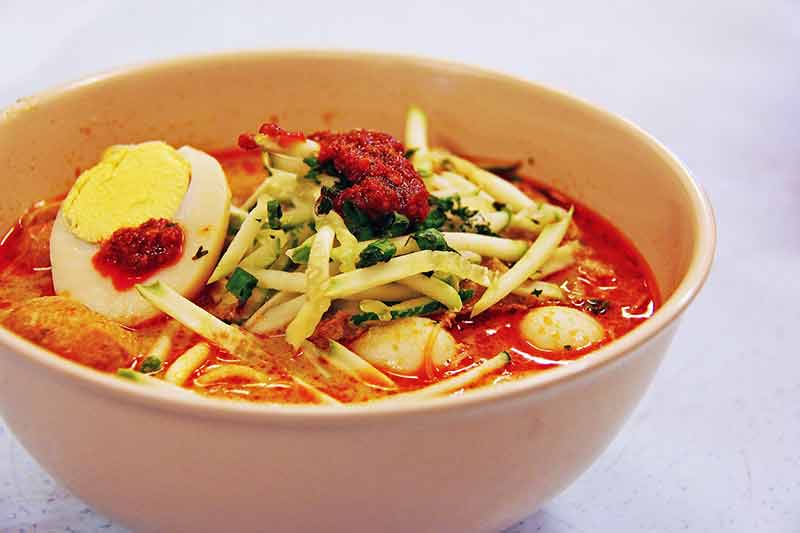
The delicious spicy Nyonya cuisine is one of Melaka’s delights.
Also known as Peranakan food in Malacca, the dishes are fresh, cheap, aromatic and extremely tasty.
You won’t have trouble finding a restaurant in Malacca that serves Nyonya cuisine.
The best Nyonya food in Melaka to are popular dishes such as Nyonya Laksa, a spicy dish of noodles cooked in thick, curried gravy with hints of lime leaves and cockles.
Nyonya Popiah, tightly packed spring rolls filled with sliced prawns and a variety of vegetables can be ordered at any Nyonya restaurant.
Also, make sure to add chicken rice ball in Melaka to your list of what to eat in Malacca.
13- Dine at the Portuguese Settlement

The roads at the Portuguese Settlement have names like Texeira and Sequeira.
Crucifixes and framed portraits of the Virgin Mary hang on the walls in the homes.
The Portuguese part of Malacca leads to the waterfront, where there are plenty of local al-fresco restaurants that dish up aromatic food.
On the menu, you’ll find curry and cook barbecued fish wrapped in aluminium foil.
14- Watch a Portuguese folk dance
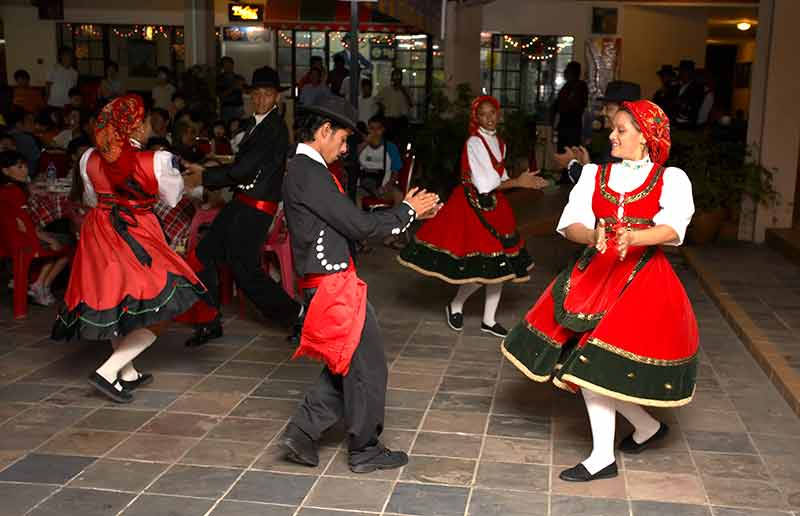
Papa Joe’s Restaurant in Medan Portuguese (Portuguese Square) is the place to watch Portuguese folk dancing on your next trip to Malacca.
You could easily be somewhere in South America, not Malaysia.
Dance groups of young men and women dressed in Portuguese peasant costumes entertain diners.
The women wear flouncy skirts with puffy-sleeved blouses, stockings and red-patterned scarves.
The young men are smartly dressed in bolero-style suits with red waistbands and black hats.
Malacca’s Portuguese community has clung to Portuguese traditions, religion and language passed down through the generations, mixing these with aspects of Malay culture.
Although they live in Malay-style houses, speak fluent Bahasa Malaysia (the national language and language of the Malay people) and dress in traditional Malay clothing, the community is staunchly Catholic.
Their unique inheritance is a Creole Portuguese, Papia Kristang, spoken only among members of the community (although a similar language is spoken in Macao).
15- Discover Kampung Chitty
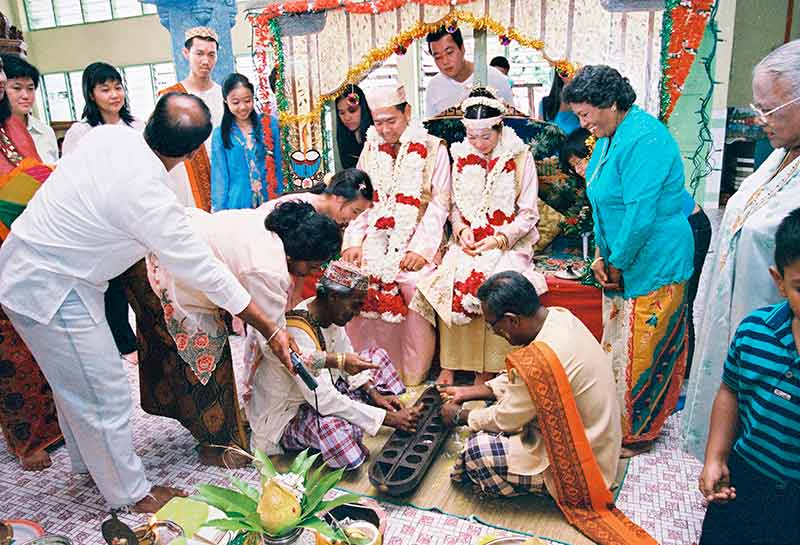
A visit to Kampong Chitty is one of the things to do in Malacca that offers another interesting peek into yet another aspect of Melaka’s culture.
The Chitty community has a low profile, even within Malaysia.
Long before Hindu prince Parameswara founded Melaka in 1401, traders from the Kalinga Empire on the Coromandel Coast of south-eastern India had already found this spice nirvana.
Over the years, their descendants gradually lost contact with their homeland and adopted local customs.
Chitty traders thrived during the Portuguese rule but when the Dutch arrived the new conquerors moved the Chitties to a two-hectare plot of farmland and relegated them to a life of farming.
Up until today, the Chitties have remained committed Hindus.
They have classical Hindu names and are divided into castes that are identified by their last names, such as the Raja (ruler), Naiker (farmer) and Pathair (goldsmith).
They continue to invite priests from southern India to conduct rites in Sanskrit (even though no one in the Chitty community understands the language).
But this is where the connection with their ancestry ends.
Their features are more Malay than Indian, as is their attire, cuisine and language.
The Chitty Living Gallery has displays of antiques, such as a Malay wedding Kris knife, an antique European-style clock, a rusty charcoal iron, metal water containers and crystal decanters.
16- Enjoy the view at Menara Taming Sari
Menara Taming Sari is an 80m-high rotating tower and the best place to get a bird’s-eye view of Melaka.
The 360-degree view of the Straits of Melaka, St. Paul’s Hill and Melaka’s old town is worth the ride.
17- Visit the Maritime Museum
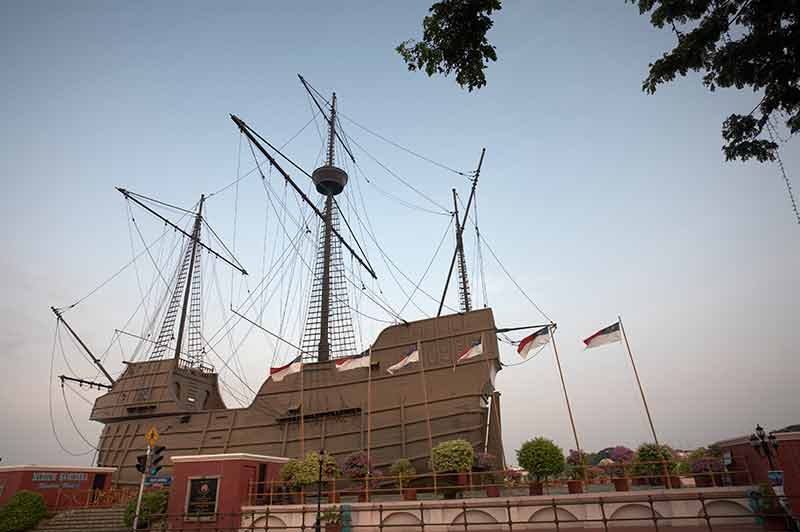
Housed in a replica of a Portuguese vessel, the Maritime Museum (Muzium Samudera) has displays that take you back into Melaka’s heady days.
The museum is a showcase of Melaka’s trading history and the displays highlight the importance the port of Melaka played in the spice trade.
18- Have fun at A Famosa theme park
If you’re wondering where to go in Malacca if you’re visiting with the family, the kids will also love A Famosa, which is a resort in Malacca with a selection of attractions.
There’s the Safari Wonderland zoo and the largest aquatic theme park in Malaysia.
A Famosa in Melaka also offers accommodation, shopping and golf.
The Old West is an attraction for cowboy and Western fans.
19- See the animals at Melaka Zoo
The second-largest Malaysian zoo, Melaka Zoo & Night Safari offers wildlife education programmes and also runs animal breeding and conservation programmes.
The Night Safari is a popular attraction as it’s cooler after dark and it’s a chance to watch nocturnal animals in their natural habitat.
There’s a bird show and on weekends, the zookeepers deliver educational talks to the public and make a show of feeding the elephants.
20- Spend the day at Melaka Wonderland
Let your hair down at Melaka Wonderland Theme Park & Resort, which is an aquatic theme park with 11 water attractions.
From the adrenaline-pumping thrill of the Tornado Chaser and Kamikaze Racer to boating or tubing on the lake, there are plenty of ways to cool off at Melaka Wonderland.
The kids will love Adventure Island, which has 360 hectares of natural forest and a multi-level water structure with slides and water jets for the kids to play.
Weather in Malacca
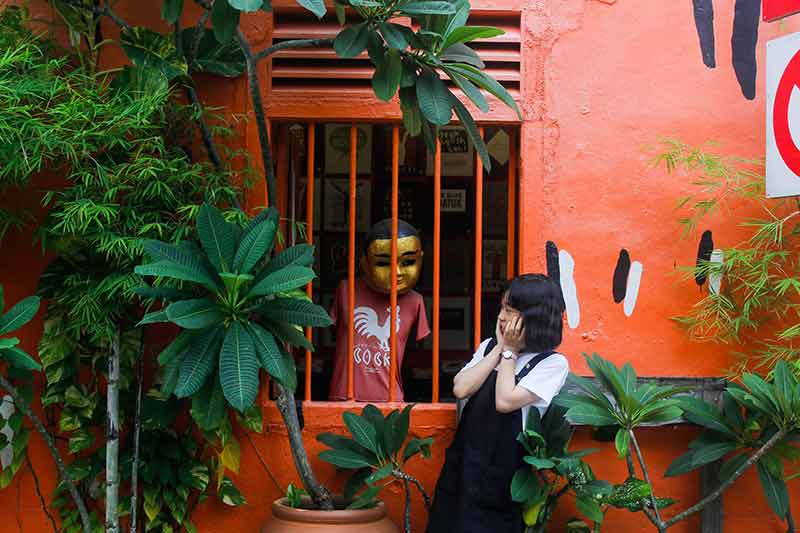
If you love exploring historical cities, don’t let the weather in Malacca deter you. It’s hot and humid pretty much all year round but the rewards of seeing the sights and delving into the history of Malacca outweighs the heat. The temperature in Malacca can range from 23 to 31C.
Choosing a hotel in Melaka
Wondering where to stay in Malacca? From homestays to high-rise hotels, there are a number of choices. And booking a hotel in Melaka is easy on the budget.
Best hotels in Melaka
Check out these hotels in Melaka for a comfortable stay:
Budget hotel in Melaka
There are plenty of hotels in Melaka for under $50 and finding a budget hotel in Melaka for around $20 a night is not that difficult. Here are three you might want to check out:
Boutique hotel in Melaka
How to get to Malacca
Getting from Singapore to Malacca
It’s possible to visit Malacca from Singapore as a day trip. Singapore is 245km (152 miles) away and it takes about three to four hours, depending on the traffic. So, a day trip to Malacca is possible if you’re prepared for a long day. If you’re travelling from Singapore, there are several ways to travel to Malacca.
Driving to Malacca
If you have a car, it’s easy enough to drive from Singapore to Malacca along the North-South Expressway (NSE). It’s the shortest route and the fastest way to get to Malacca. The drive takes about 3 hours and the speed limit is 110km an hour.
Having your own car means you can stop anytime you like and see the sights along the way. However, if you’ll need to make a detour if you plan to visit tourist stops such as Batu Caves and Buddhist House, which will add to your travel time.
Be warned that the traffic between Singapore and Johor Bahru is horrendous during peak time (7 am to 9 am) and after 6 pm.
Cost: If you’re not keen on driving, a transfer in a private car costs from S$80 for a one-way trip.
2- Singapore to Malacca bus
A stress-free way to travel is to catch a Singapore bus to Malacca.
The bus or coach to Malacca takes about four hours and you’ll be required to get off the bus to clear immigration at the Woodlands Checkpoint. The immigration stop can take up to an hour.
There are several bus companies such as KKKL Express, Konsortium, Starmart Express and WTS Travel buses depart from a number of places in Singapore.
Cost of the bus from Singapore to Melaka is around SGD25 for a one-way trip
3- Train to Malacca from Singapore
Taking the train to Malacca is the least convenient option as you’ll need to take the train from Woodlands Train Station in Singapore and change trains at JB Sentral Station for Malacca.
The train journey takes about 5 to 6 hours and you’ll need to catch a bus from the train station to Malacca city.
Getting from KL to Malacca
Melaka is 145km to the south of Kuala Lumpur and can easily be visited as a day trip from KL. Here are the best ways to travel from KL to Melaka.
1- KL to Melaka bus
Buses from KL to Melaka depart regularly throughout the day from Terminal Bersepadu Selatan in Kuala Lumpur. The KL to Melaka bus takes 2.5 hours and costs no more than USD5.
2- Taxi from KL to Melaka
The most convenient way to get to Melaka from KL is by taxi, which costs around USD50 one way but you could try to negotiate a fixed price for a return trip with the taxi driver.
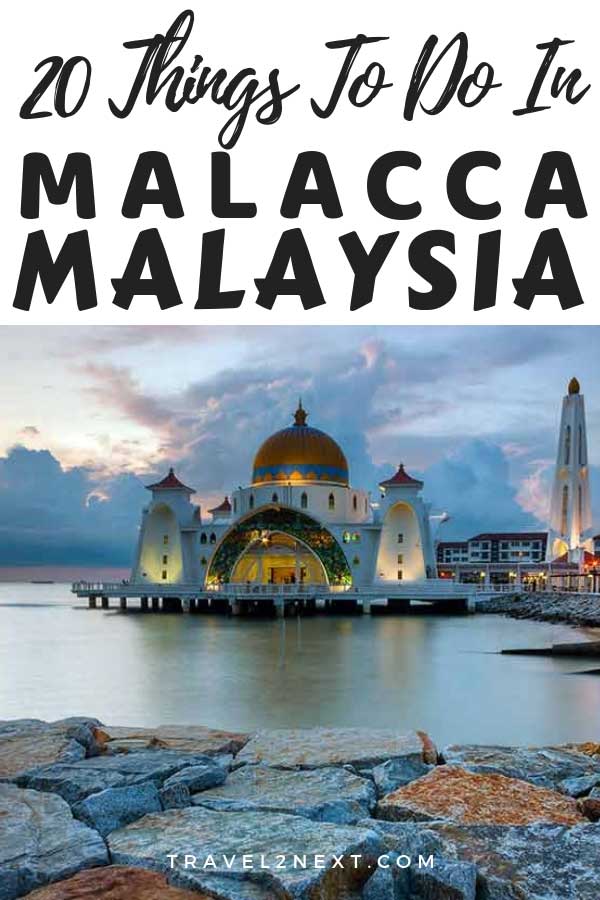
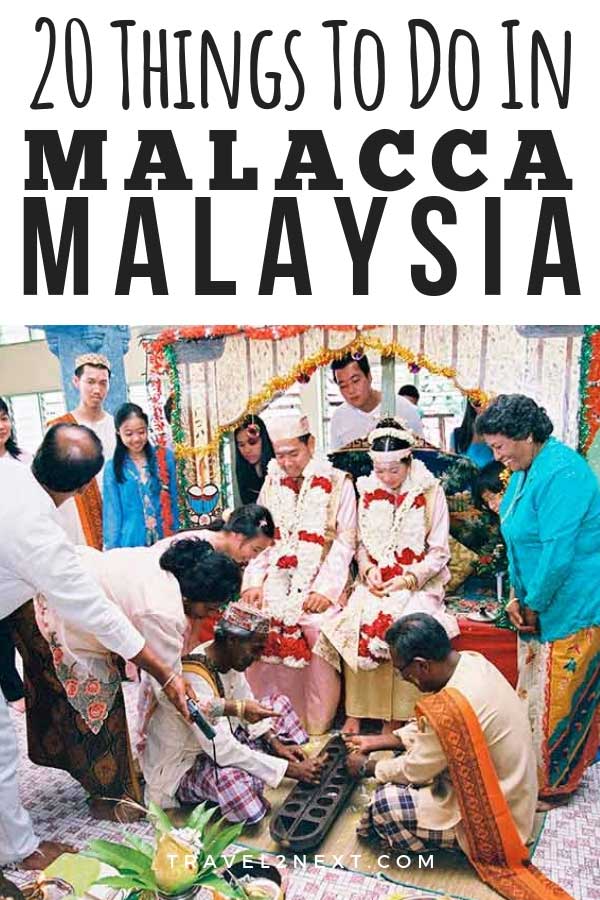
Plan Your Trip

Rent A Car – Find the best car rental rates at Discover Cars. They compare car hire companies to provide you with the best deal right now.

Find A Hotel – If you’re curious about this article and are looking for somewhere to stay, take a look at these amazing hotels.

